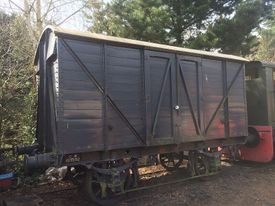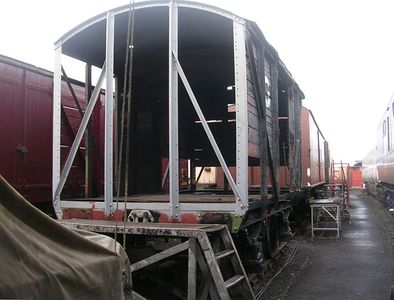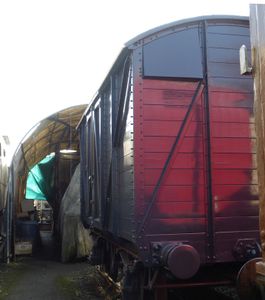GWR 103592 Mink 'A' Covered Goods Van
| GWR 103592 Mink 'A' Covered Goods Van | |
|---|---|
 GWR 103592 Mink 'A' Covered Goods Van in Bewdley Yard (March 2021) | |
| Built By | GWR Swindon |
| Status | Under repair |
| Number | 103592 |
| History | |
| Built | 1923 |
| Diagram | V14 |
| Lot | 901 |
| Type | 4-w ventilated van |
| Capacity | 12 tons |
| Telegraphic code | MINK A |
| 1987 | Arrived on SVR |
| c 2008 | Restored |
In the earliest days merchandise was carried in open wagons, covered by a tarpaulin if necessary. During the 1860s the GWR began to build covered goods vans with wooden bodies and body frames. Between 1886 and 1901 they were built of iron and became known as an 'IRON MINK'. After that time the GWR reverted to wooden body construction but with iron angle section frames. MINK A Diagram V14 was first introduced in 1912, with 1,625 examples built by 1923. These were the standard 16ft length over the headstocks with a 9ft wheelbase and had a 10-ton capacity. A further 2,186 were built between 1923 and 1927 to the same Diagram and dimensions but with a 12-ton capacity, requiring an increase in the size of the journals from 8in by 4in to 9in by 5½in.[note 1] Both types had ventilation provided by two bonnets at each end of the van.[1]
The SVR is home to four MINK As, of which 93016 and 93045 are of the early 10-ton type while 101961 and 103592 are of the later 12-ton type.
Contents
Service and preservation
103592 entered GWR service in 1923 and continued in use with BR(W). It was then used at British Steel in Sheffield, from where it was acquired for preservation by the The GWR 813 Preservation Fund, arriving on the SVR on 6 May 1987. A photograph of 103592 at Bewdley in May 1988 shows the wagon in pale yellow paint.
103592 spent a number of years in need of restoration. The 1999 Stock Book noted that the wagon still required major renovation before use, not helped by being regularly "blown up" for demonstration purposes at War Weekend events.[2]
Between 2006 and 2008 the Guarantee Company helped fund a sympathetically styled 'tin shed' next to the Goods Shed in Bewdley yard to replace a life-expired container which had been used as a store. SVR News noted that the completed shed has been electrically wired by the volunteers from the 1501 group in a break from their extensive overhaul of GWR Mink A 103592.[3] The picture below shows work on 103592 still in progress the following year.
After the restoration was completed, 103592 spent time in use as a store at the back of Bewdley Yard as pictured below. In March 2021 a shunt brought the wagon out into the open as seen in the main photograph above.
See also
Notes
- ↑ The ends (or journals) of the axles rotate in bearings inside the axleboxes. The journal length and diameter are larger on vehicles with a higher Tare/load capacity.
References
- ↑ 1.0 1.1 Atkins, Beard & Tourret (2013) pp. 33-34, 379.
- ↑ SVR Stock Book Ninth Edition
- ↑ SVR News 163

